Business Decision Analytics: A Reflective Report on Decision Making
VerifiedAdded on 2023/04/12
|9
|1230
|262
Report
AI Summary
This report presents a reflection on business decision analytics, utilizing Kolb's reflective cycle to analyze a personal experience. The introduction highlights the importance of decision-making in leadership roles and sets the stage for a detailed examination of the author's experience as a product manager in a cosmetic company. The reflection section applies Kolb's four-stage cycle, detailing a concrete experience involving the development of a new product, specifically an organic cosmetic range, and the application of conceptual decision-making style. The report discusses the use of decision-making tools such as SWOT and cost-benefit analyses, and the decision-making style adopted. The reflective observation stage considers the context of the experience, the tools used, and the balance between intuition and rationality. The abstract conceptualization stage identifies key learnings, including the importance of communication, time management, environmental analysis, and feasibility studies. Finally, the active experimentation stage outlines how these learnings would be applied in future similar situations, including the potential use of analytical decision-making and a time management matrix. The conclusion summarizes the key points, emphasizing the effectiveness of reflection in learning from experience and the differences between conceptual and analytical decision-making styles. The report also references various sources.
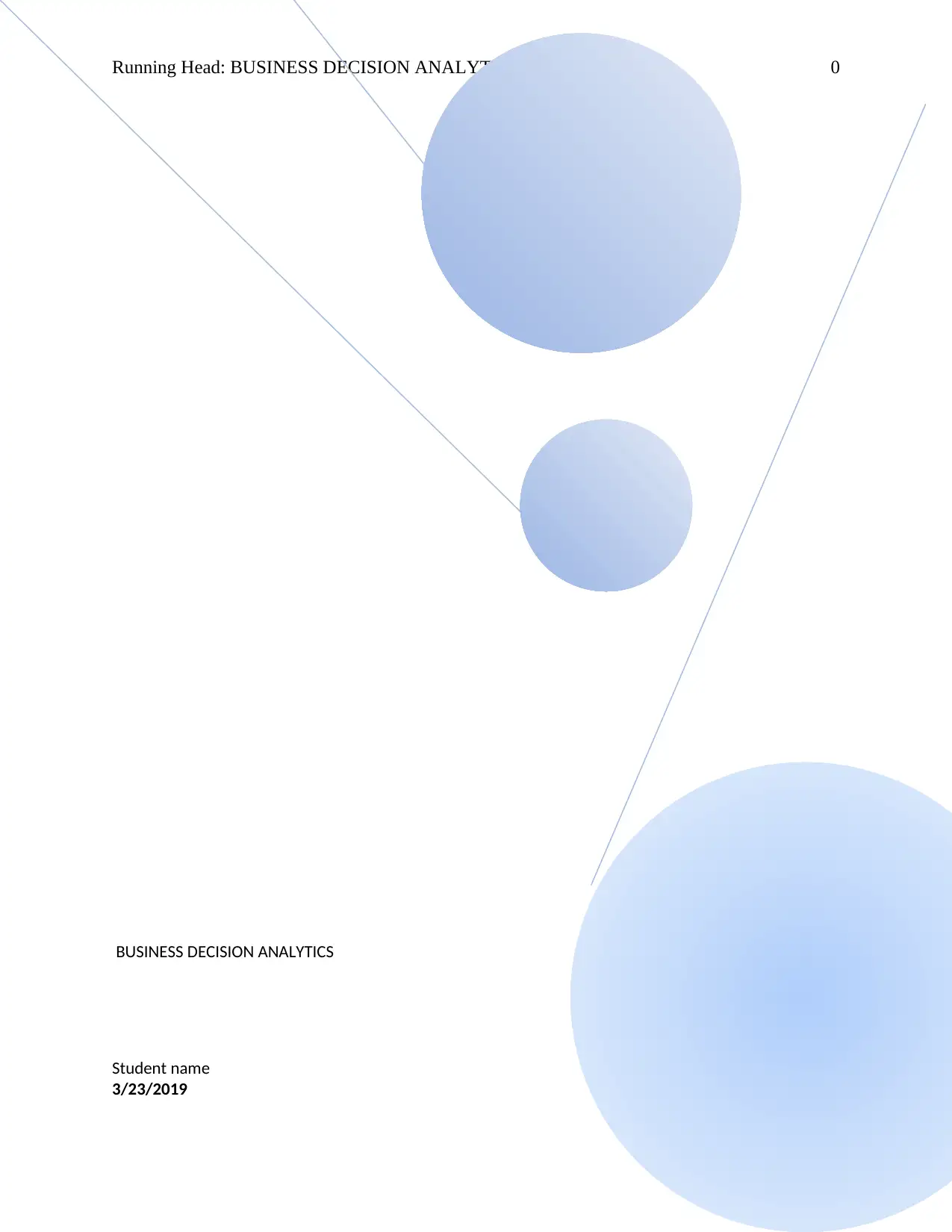
Running Head: BUSINESS DECISION ANALYTICS 0
BUSINESS DECISION ANALYTICS
Student name
3/23/2019
BUSINESS DECISION ANALYTICS
Student name
3/23/2019
Paraphrase This Document
Need a fresh take? Get an instant paraphrase of this document with our AI Paraphraser
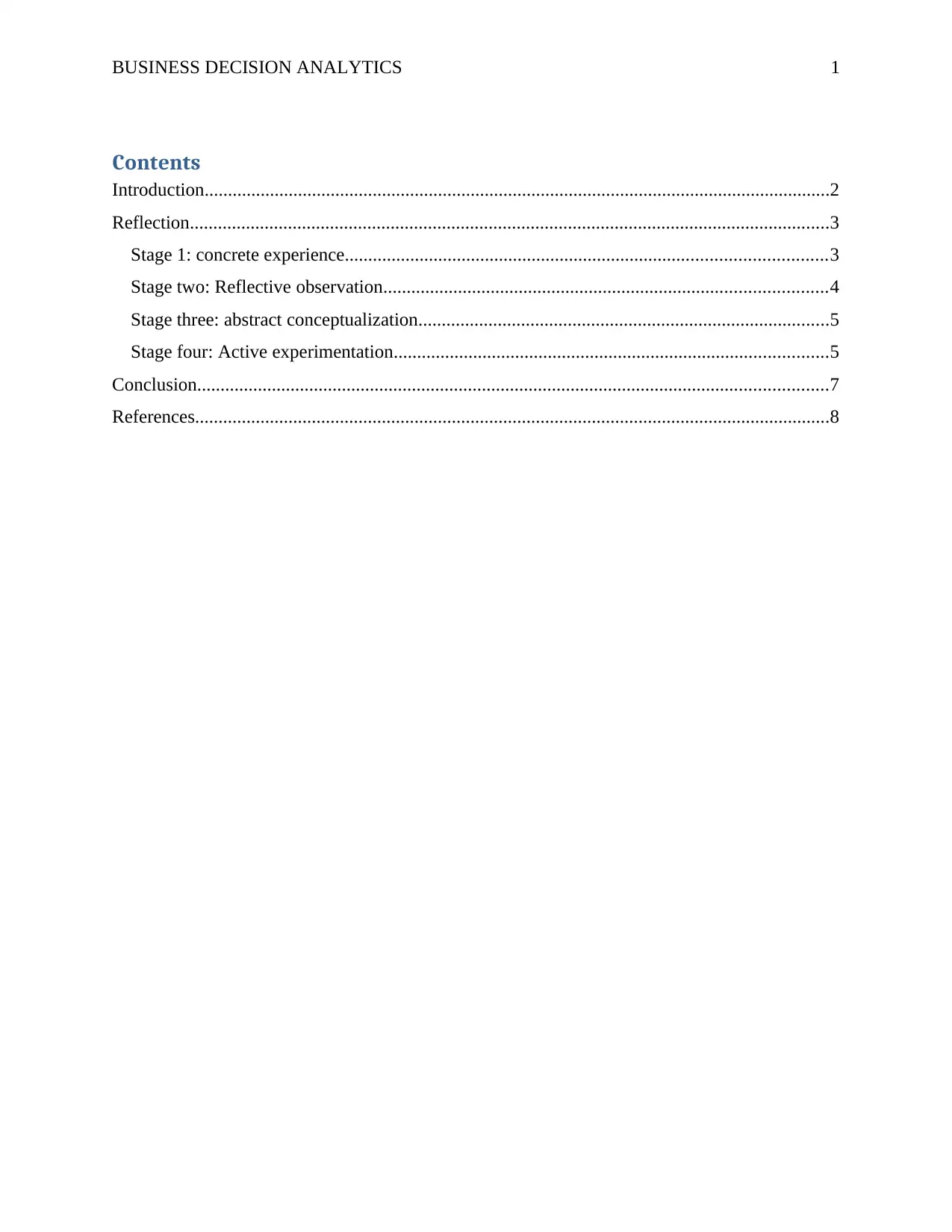
BUSINESS DECISION ANALYTICS 1
Contents
Introduction......................................................................................................................................2
Reflection.........................................................................................................................................3
Stage 1: concrete experience.......................................................................................................3
Stage two: Reflective observation...............................................................................................4
Stage three: abstract conceptualization........................................................................................5
Stage four: Active experimentation.............................................................................................5
Conclusion.......................................................................................................................................7
References........................................................................................................................................8
Contents
Introduction......................................................................................................................................2
Reflection.........................................................................................................................................3
Stage 1: concrete experience.......................................................................................................3
Stage two: Reflective observation...............................................................................................4
Stage three: abstract conceptualization........................................................................................5
Stage four: Active experimentation.............................................................................................5
Conclusion.......................................................................................................................................7
References........................................................................................................................................8
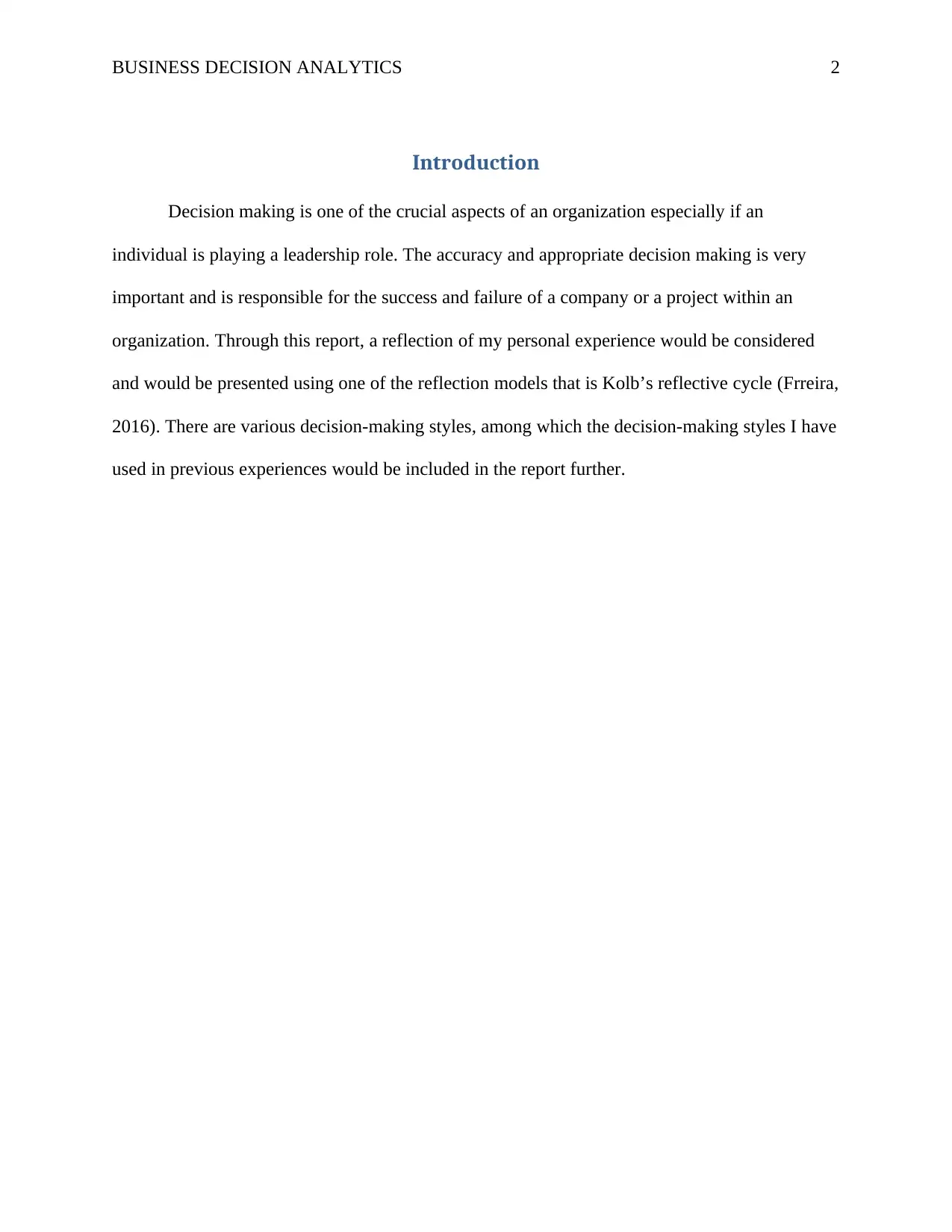
BUSINESS DECISION ANALYTICS 2
Introduction
Decision making is one of the crucial aspects of an organization especially if an
individual is playing a leadership role. The accuracy and appropriate decision making is very
important and is responsible for the success and failure of a company or a project within an
organization. Through this report, a reflection of my personal experience would be considered
and would be presented using one of the reflection models that is Kolb’s reflective cycle (Frreira,
2016). There are various decision-making styles, among which the decision-making styles I have
used in previous experiences would be included in the report further.
Introduction
Decision making is one of the crucial aspects of an organization especially if an
individual is playing a leadership role. The accuracy and appropriate decision making is very
important and is responsible for the success and failure of a company or a project within an
organization. Through this report, a reflection of my personal experience would be considered
and would be presented using one of the reflection models that is Kolb’s reflective cycle (Frreira,
2016). There are various decision-making styles, among which the decision-making styles I have
used in previous experiences would be included in the report further.
⊘ This is a preview!⊘
Do you want full access?
Subscribe today to unlock all pages.

Trusted by 1+ million students worldwide
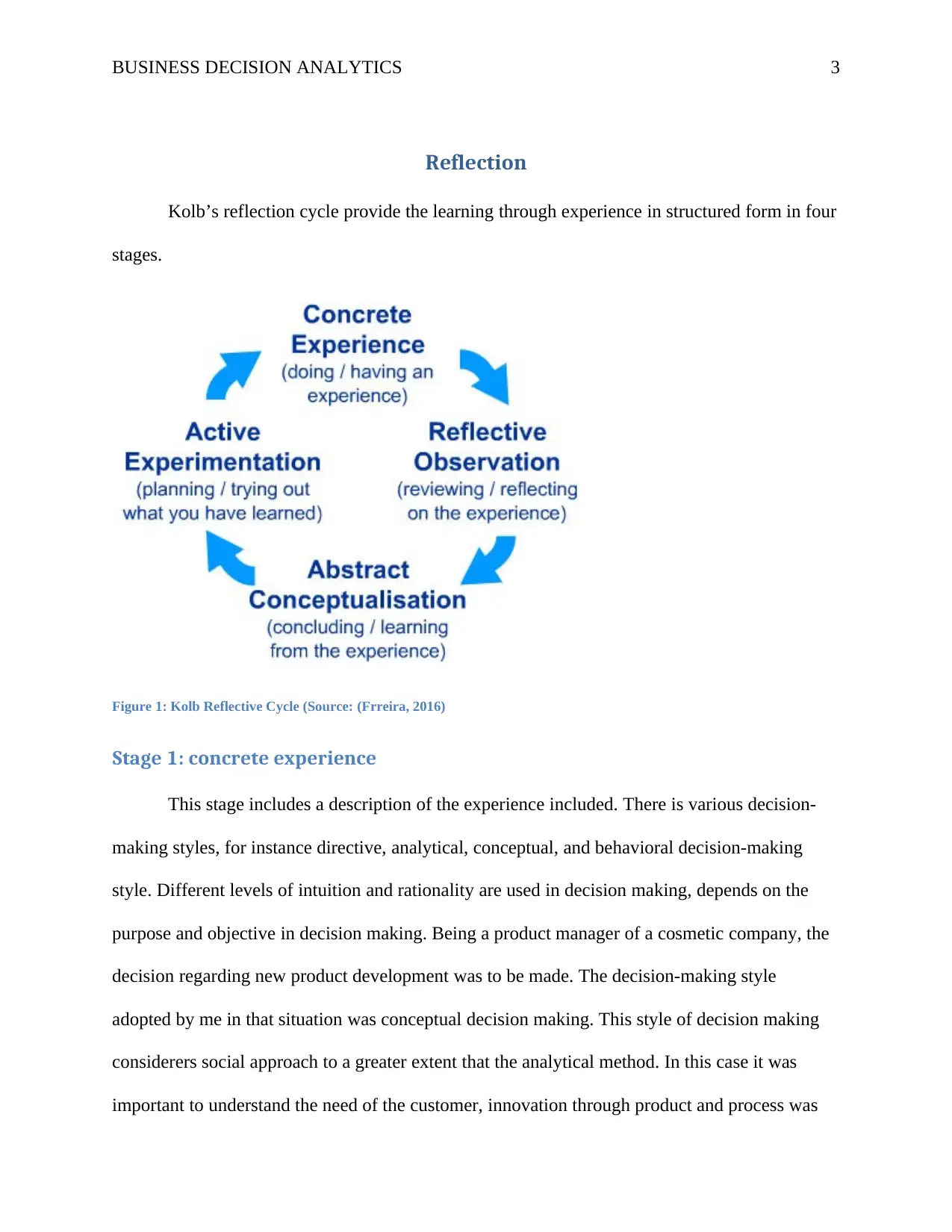
BUSINESS DECISION ANALYTICS 3
Reflection
Kolb’s reflection cycle provide the learning through experience in structured form in four
stages.
Figure 1: Kolb Reflective Cycle (Source: (Frreira, 2016)
Stage 1: concrete experience
This stage includes a description of the experience included. There is various decision-
making styles, for instance directive, analytical, conceptual, and behavioral decision-making
style. Different levels of intuition and rationality are used in decision making, depends on the
purpose and objective in decision making. Being a product manager of a cosmetic company, the
decision regarding new product development was to be made. The decision-making style
adopted by me in that situation was conceptual decision making. This style of decision making
considerers social approach to a greater extent that the analytical method. In this case it was
important to understand the need of the customer, innovation through product and process was
Reflection
Kolb’s reflection cycle provide the learning through experience in structured form in four
stages.
Figure 1: Kolb Reflective Cycle (Source: (Frreira, 2016)
Stage 1: concrete experience
This stage includes a description of the experience included. There is various decision-
making styles, for instance directive, analytical, conceptual, and behavioral decision-making
style. Different levels of intuition and rationality are used in decision making, depends on the
purpose and objective in decision making. Being a product manager of a cosmetic company, the
decision regarding new product development was to be made. The decision-making style
adopted by me in that situation was conceptual decision making. This style of decision making
considerers social approach to a greater extent that the analytical method. In this case it was
important to understand the need of the customer, innovation through product and process was
Paraphrase This Document
Need a fresh take? Get an instant paraphrase of this document with our AI Paraphraser
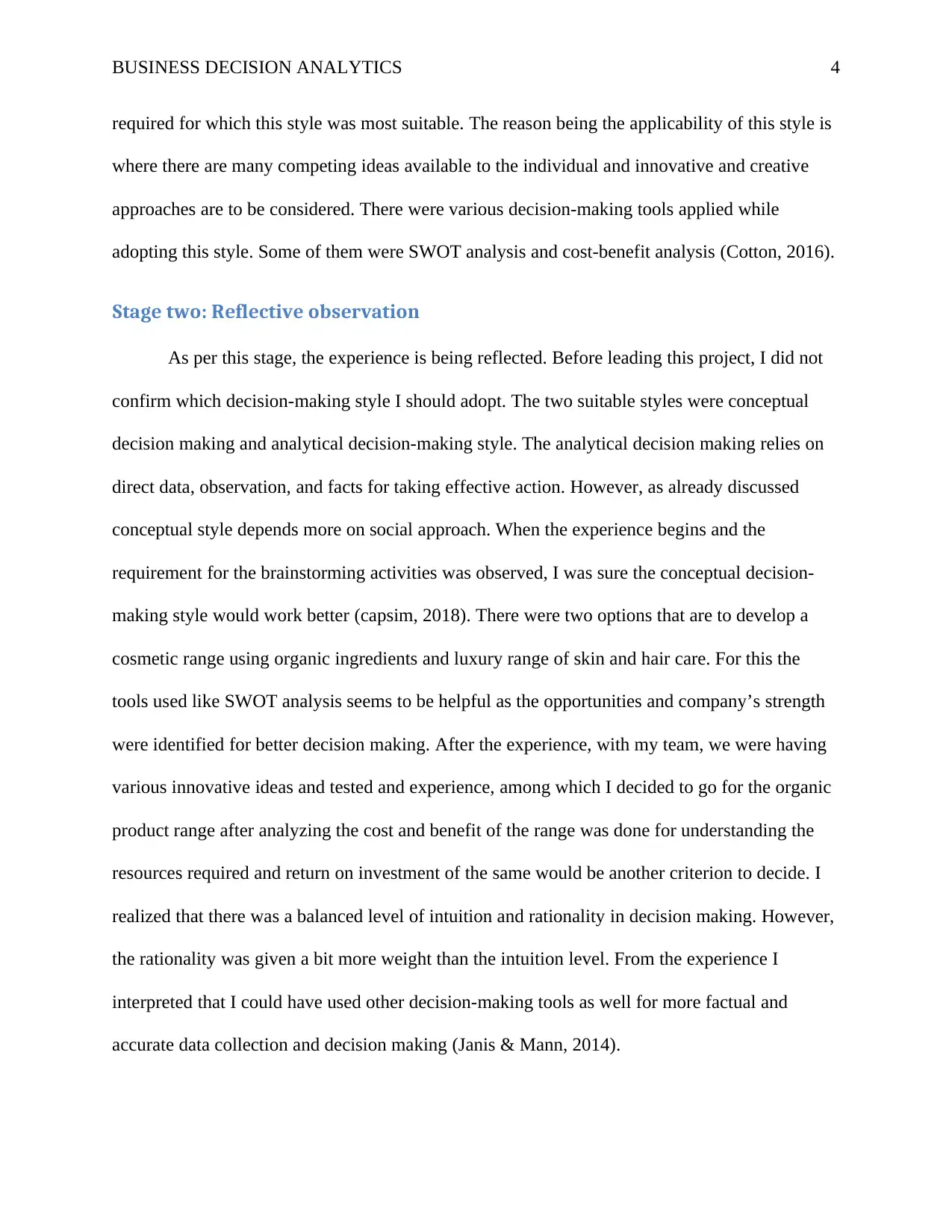
BUSINESS DECISION ANALYTICS 4
required for which this style was most suitable. The reason being the applicability of this style is
where there are many competing ideas available to the individual and innovative and creative
approaches are to be considered. There were various decision-making tools applied while
adopting this style. Some of them were SWOT analysis and cost-benefit analysis (Cotton, 2016).
Stage two: Reflective observation
As per this stage, the experience is being reflected. Before leading this project, I did not
confirm which decision-making style I should adopt. The two suitable styles were conceptual
decision making and analytical decision-making style. The analytical decision making relies on
direct data, observation, and facts for taking effective action. However, as already discussed
conceptual style depends more on social approach. When the experience begins and the
requirement for the brainstorming activities was observed, I was sure the conceptual decision-
making style would work better (capsim, 2018). There were two options that are to develop a
cosmetic range using organic ingredients and luxury range of skin and hair care. For this the
tools used like SWOT analysis seems to be helpful as the opportunities and company’s strength
were identified for better decision making. After the experience, with my team, we were having
various innovative ideas and tested and experience, among which I decided to go for the organic
product range after analyzing the cost and benefit of the range was done for understanding the
resources required and return on investment of the same would be another criterion to decide. I
realized that there was a balanced level of intuition and rationality in decision making. However,
the rationality was given a bit more weight than the intuition level. From the experience I
interpreted that I could have used other decision-making tools as well for more factual and
accurate data collection and decision making (Janis & Mann, 2014).
required for which this style was most suitable. The reason being the applicability of this style is
where there are many competing ideas available to the individual and innovative and creative
approaches are to be considered. There were various decision-making tools applied while
adopting this style. Some of them were SWOT analysis and cost-benefit analysis (Cotton, 2016).
Stage two: Reflective observation
As per this stage, the experience is being reflected. Before leading this project, I did not
confirm which decision-making style I should adopt. The two suitable styles were conceptual
decision making and analytical decision-making style. The analytical decision making relies on
direct data, observation, and facts for taking effective action. However, as already discussed
conceptual style depends more on social approach. When the experience begins and the
requirement for the brainstorming activities was observed, I was sure the conceptual decision-
making style would work better (capsim, 2018). There were two options that are to develop a
cosmetic range using organic ingredients and luxury range of skin and hair care. For this the
tools used like SWOT analysis seems to be helpful as the opportunities and company’s strength
were identified for better decision making. After the experience, with my team, we were having
various innovative ideas and tested and experience, among which I decided to go for the organic
product range after analyzing the cost and benefit of the range was done for understanding the
resources required and return on investment of the same would be another criterion to decide. I
realized that there was a balanced level of intuition and rationality in decision making. However,
the rationality was given a bit more weight than the intuition level. From the experience I
interpreted that I could have used other decision-making tools as well for more factual and
accurate data collection and decision making (Janis & Mann, 2014).
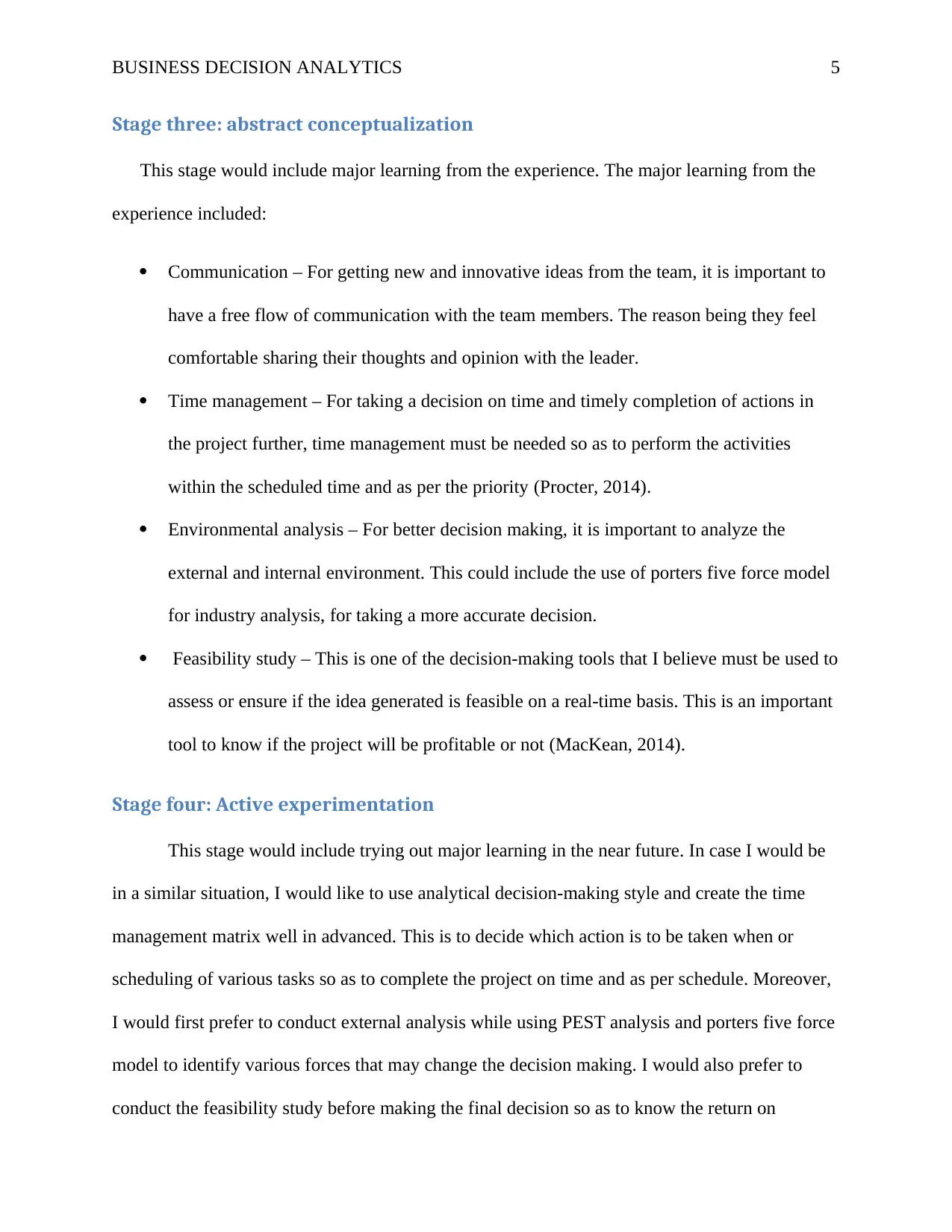
BUSINESS DECISION ANALYTICS 5
Stage three: abstract conceptualization
This stage would include major learning from the experience. The major learning from the
experience included:
Communication – For getting new and innovative ideas from the team, it is important to
have a free flow of communication with the team members. The reason being they feel
comfortable sharing their thoughts and opinion with the leader.
Time management – For taking a decision on time and timely completion of actions in
the project further, time management must be needed so as to perform the activities
within the scheduled time and as per the priority (Procter, 2014).
Environmental analysis – For better decision making, it is important to analyze the
external and internal environment. This could include the use of porters five force model
for industry analysis, for taking a more accurate decision.
Feasibility study – This is one of the decision-making tools that I believe must be used to
assess or ensure if the idea generated is feasible on a real-time basis. This is an important
tool to know if the project will be profitable or not (MacKean, 2014).
Stage four: Active experimentation
This stage would include trying out major learning in the near future. In case I would be
in a similar situation, I would like to use analytical decision-making style and create the time
management matrix well in advanced. This is to decide which action is to be taken when or
scheduling of various tasks so as to complete the project on time and as per schedule. Moreover,
I would first prefer to conduct external analysis while using PEST analysis and porters five force
model to identify various forces that may change the decision making. I would also prefer to
conduct the feasibility study before making the final decision so as to know the return on
Stage three: abstract conceptualization
This stage would include major learning from the experience. The major learning from the
experience included:
Communication – For getting new and innovative ideas from the team, it is important to
have a free flow of communication with the team members. The reason being they feel
comfortable sharing their thoughts and opinion with the leader.
Time management – For taking a decision on time and timely completion of actions in
the project further, time management must be needed so as to perform the activities
within the scheduled time and as per the priority (Procter, 2014).
Environmental analysis – For better decision making, it is important to analyze the
external and internal environment. This could include the use of porters five force model
for industry analysis, for taking a more accurate decision.
Feasibility study – This is one of the decision-making tools that I believe must be used to
assess or ensure if the idea generated is feasible on a real-time basis. This is an important
tool to know if the project will be profitable or not (MacKean, 2014).
Stage four: Active experimentation
This stage would include trying out major learning in the near future. In case I would be
in a similar situation, I would like to use analytical decision-making style and create the time
management matrix well in advanced. This is to decide which action is to be taken when or
scheduling of various tasks so as to complete the project on time and as per schedule. Moreover,
I would first prefer to conduct external analysis while using PEST analysis and porters five force
model to identify various forces that may change the decision making. I would also prefer to
conduct the feasibility study before making the final decision so as to know the return on
⊘ This is a preview!⊘
Do you want full access?
Subscribe today to unlock all pages.

Trusted by 1+ million students worldwide

BUSINESS DECISION ANALYTICS 6
investment, and will the decision was taken helpful in earning the revenue to gain profitability of
the company (Procter, 2014).
investment, and will the decision was taken helpful in earning the revenue to gain profitability of
the company (Procter, 2014).
Paraphrase This Document
Need a fresh take? Get an instant paraphrase of this document with our AI Paraphraser
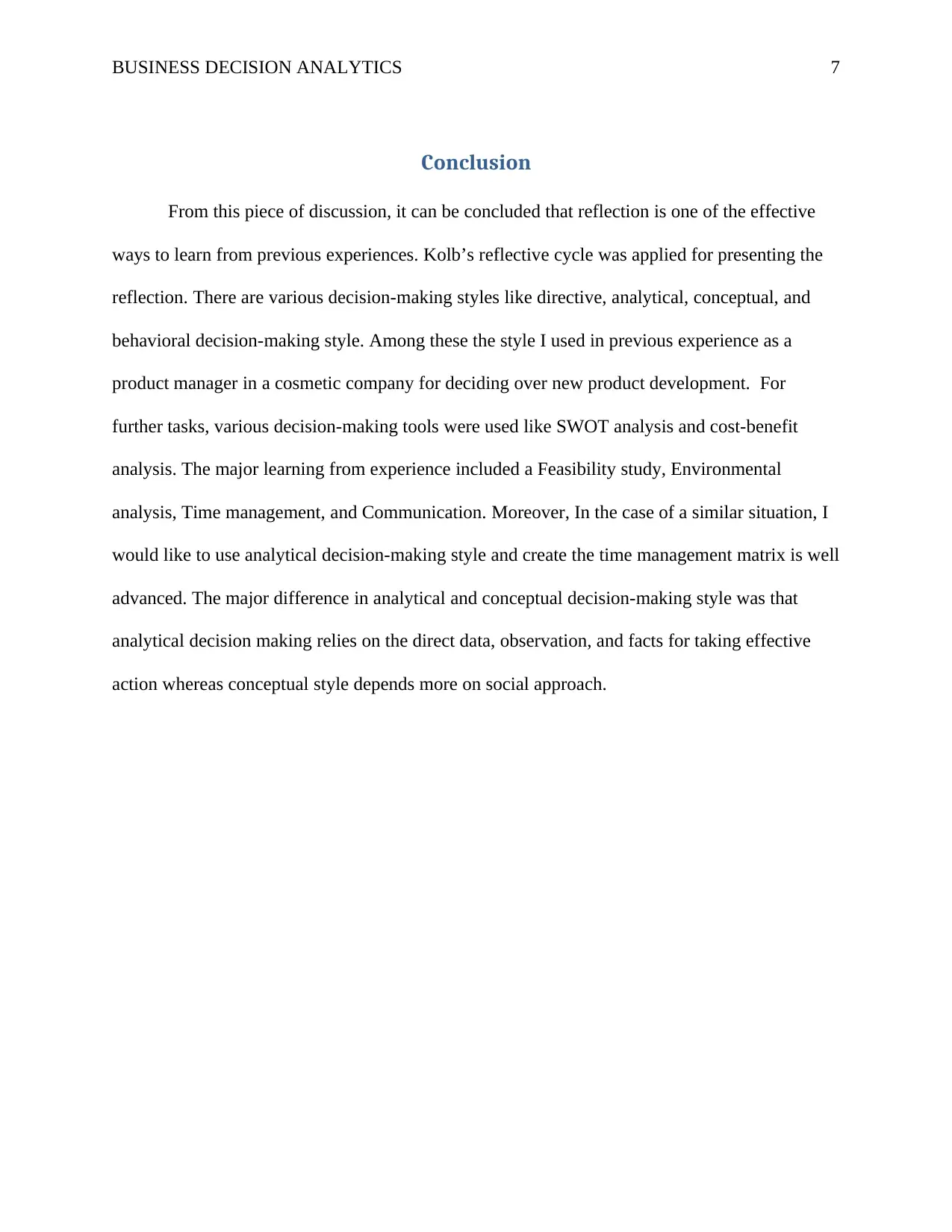
BUSINESS DECISION ANALYTICS 7
Conclusion
From this piece of discussion, it can be concluded that reflection is one of the effective
ways to learn from previous experiences. Kolb’s reflective cycle was applied for presenting the
reflection. There are various decision-making styles like directive, analytical, conceptual, and
behavioral decision-making style. Among these the style I used in previous experience as a
product manager in a cosmetic company for deciding over new product development. For
further tasks, various decision-making tools were used like SWOT analysis and cost-benefit
analysis. The major learning from experience included a Feasibility study, Environmental
analysis, Time management, and Communication. Moreover, In the case of a similar situation, I
would like to use analytical decision-making style and create the time management matrix is well
advanced. The major difference in analytical and conceptual decision-making style was that
analytical decision making relies on the direct data, observation, and facts for taking effective
action whereas conceptual style depends more on social approach.
Conclusion
From this piece of discussion, it can be concluded that reflection is one of the effective
ways to learn from previous experiences. Kolb’s reflective cycle was applied for presenting the
reflection. There are various decision-making styles like directive, analytical, conceptual, and
behavioral decision-making style. Among these the style I used in previous experience as a
product manager in a cosmetic company for deciding over new product development. For
further tasks, various decision-making tools were used like SWOT analysis and cost-benefit
analysis. The major learning from experience included a Feasibility study, Environmental
analysis, Time management, and Communication. Moreover, In the case of a similar situation, I
would like to use analytical decision-making style and create the time management matrix is well
advanced. The major difference in analytical and conceptual decision-making style was that
analytical decision making relies on the direct data, observation, and facts for taking effective
action whereas conceptual style depends more on social approach.
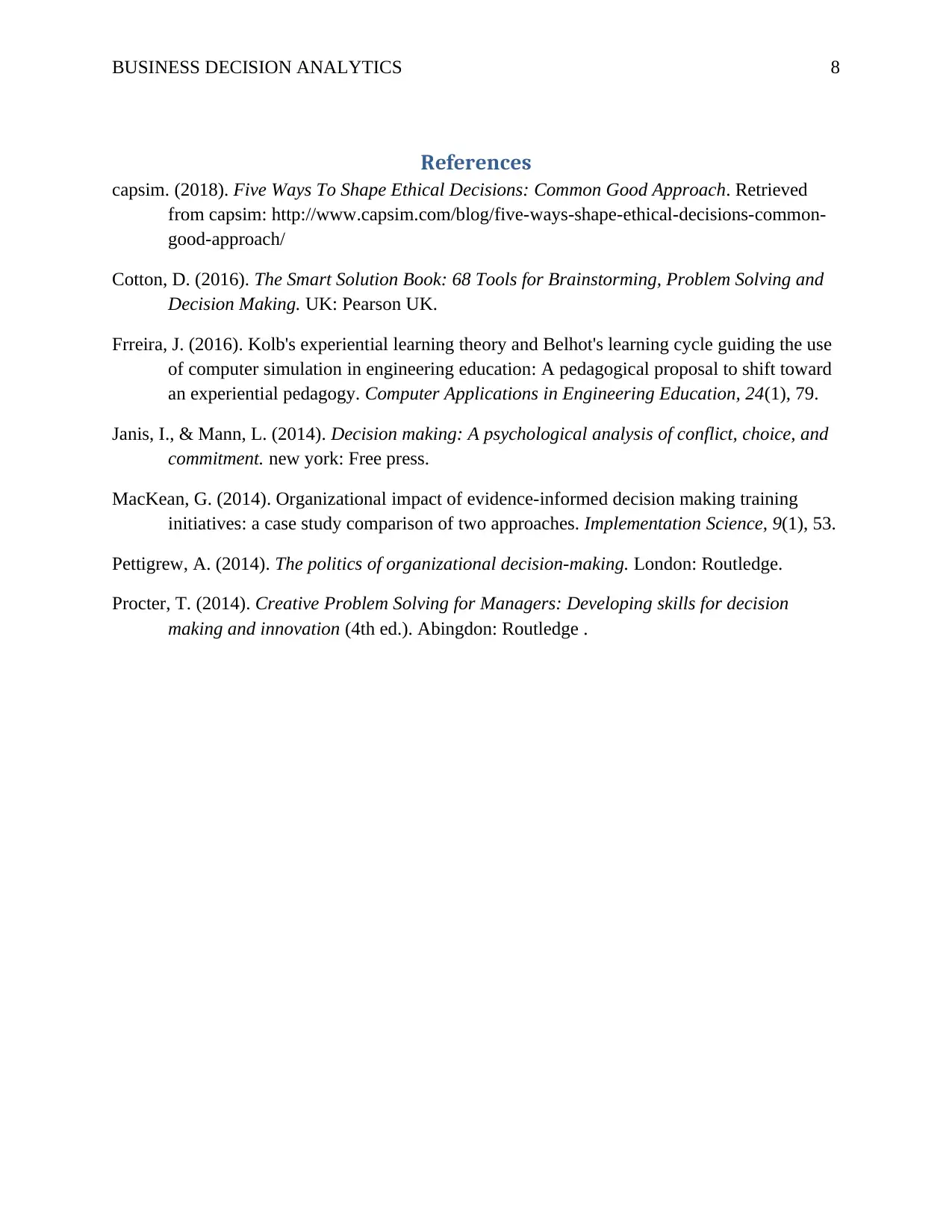
BUSINESS DECISION ANALYTICS 8
References
capsim. (2018). Five Ways To Shape Ethical Decisions: Common Good Approach. Retrieved
from capsim: http://www.capsim.com/blog/five-ways-shape-ethical-decisions-common-
good-approach/
Cotton, D. (2016). The Smart Solution Book: 68 Tools for Brainstorming, Problem Solving and
Decision Making. UK: Pearson UK.
Frreira, J. (2016). Kolb's experiential learning theory and Belhot's learning cycle guiding the use
of computer simulation in engineering education: A pedagogical proposal to shift toward
an experiential pedagogy. Computer Applications in Engineering Education, 24(1), 79.
Janis, I., & Mann, L. (2014). Decision making: A psychological analysis of conflict, choice, and
commitment. new york: Free press.
MacKean, G. (2014). Organizational impact of evidence-informed decision making training
initiatives: a case study comparison of two approaches. Implementation Science, 9(1), 53.
Pettigrew, A. (2014). The politics of organizational decision-making. London: Routledge.
Procter, T. (2014). Creative Problem Solving for Managers: Developing skills for decision
making and innovation (4th ed.). Abingdon: Routledge .
References
capsim. (2018). Five Ways To Shape Ethical Decisions: Common Good Approach. Retrieved
from capsim: http://www.capsim.com/blog/five-ways-shape-ethical-decisions-common-
good-approach/
Cotton, D. (2016). The Smart Solution Book: 68 Tools for Brainstorming, Problem Solving and
Decision Making. UK: Pearson UK.
Frreira, J. (2016). Kolb's experiential learning theory and Belhot's learning cycle guiding the use
of computer simulation in engineering education: A pedagogical proposal to shift toward
an experiential pedagogy. Computer Applications in Engineering Education, 24(1), 79.
Janis, I., & Mann, L. (2014). Decision making: A psychological analysis of conflict, choice, and
commitment. new york: Free press.
MacKean, G. (2014). Organizational impact of evidence-informed decision making training
initiatives: a case study comparison of two approaches. Implementation Science, 9(1), 53.
Pettigrew, A. (2014). The politics of organizational decision-making. London: Routledge.
Procter, T. (2014). Creative Problem Solving for Managers: Developing skills for decision
making and innovation (4th ed.). Abingdon: Routledge .
⊘ This is a preview!⊘
Do you want full access?
Subscribe today to unlock all pages.

Trusted by 1+ million students worldwide
1 out of 9
Related Documents
Your All-in-One AI-Powered Toolkit for Academic Success.
+13062052269
info@desklib.com
Available 24*7 on WhatsApp / Email
![[object Object]](/_next/static/media/star-bottom.7253800d.svg)
Unlock your academic potential
Copyright © 2020–2025 A2Z Services. All Rights Reserved. Developed and managed by ZUCOL.





